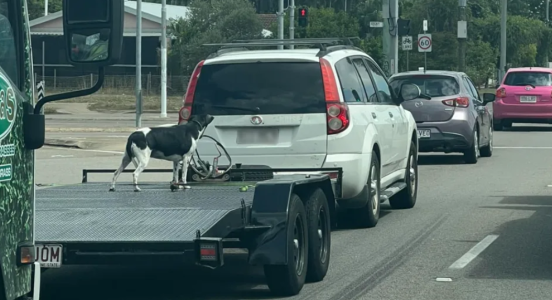Driver's controversial road act reaps criticisms online
By
- Replies 9
The sight of a dog tied to the back of a ute or trailer is common in Australia.
While it's legal in most cases, provided the animal is securely fastened, the methods some dog owners use to restrain their pets are causing concern and sparking heated debates.
A black and white dog was spotted recently on the back of a trailer in Townsville.
The dog was restrained by a strap attached to a jumble of wires, which also connected the vehicle and trailer.
A photograph taken by a nearby driver shows the dog's tail tucked firmly between its hind legs, its ears flattened and sticking out to the sides, and its stance wide and braced.
Many people have criticised this act as 'cruel' and 'irresponsible', arguing that the dog's wellbeing and safety are not prioritised in such situations.
'Irresponsible pet owner right there,' one local commented online.
While others expressed concern about the dog being exposed to the heat with no cover, standing on the hot metal tray.
'That floor would be hot under its feet,' another person noted.
'Poor dog,' one person remarked.
However, some dog owners argue that their pets love and enjoy being out in the open or in the outer space of the vehicle rather than being confined inside a car.
'They love riding utes!' they claimed.
In Queensland, dogs can only be ferried or transported on a trailer or ute if they are sure that the dogs are secured in a way that prevents them from falling or moving off the vehicle and ensures they cannot be harmed or injured by any vehicle movement.
As of the moment, there are three legal ways Aussies can transport their pets or dogs on the roads—inside the vehicle, inside a cage or canopy, or by tying them up.
Despite tying them up or tethering being a 'usual' choice, it is the RSPCA's 'less preferred' method.
'Generally inside the vehicle with a dog attached to a harness and collar...that's the best way,' RSPCA Queensland Inspector Kyle Patrech previously told a news source.
'[Unlike tethering] the other two methods at least provide the animal with some protection from the elements...we try to work around the third way of using a harness or tether attached to the very middle of the tray.'
According to the Queensland government, thousands of dogs are injured every year due to owners incorrectly restraining their dogs to the back of a ute or trailer.
Dog owners can face a maximum penalty of $9,288 in such cases.
Regardless of the method used to transport your pets or dogs, it's important to ensure that the dog is not exposed to extreme weather conditions.
The metal trays of utes and trailers can become extremely hot in the sun, potentially burning the dog's paws.
Similarly, in cold weather, the metal can become very cold, causing discomfort to the dog.
While it's legal to transport dogs on the back of utes or trailers in Australia, it's crucial to do so in a way that prioritises the animal's safety and wellbeing.
Failure to do so can result in hefty fines and, more importantly, harm to the animal.

What are your thoughts on this issue, members? Have you seen similar instances in your local area? Share your experiences and opinions in the comments below.
While it's legal in most cases, provided the animal is securely fastened, the methods some dog owners use to restrain their pets are causing concern and sparking heated debates.
A black and white dog was spotted recently on the back of a trailer in Townsville.
The dog was restrained by a strap attached to a jumble of wires, which also connected the vehicle and trailer.
A photograph taken by a nearby driver shows the dog's tail tucked firmly between its hind legs, its ears flattened and sticking out to the sides, and its stance wide and braced.
Many people have criticised this act as 'cruel' and 'irresponsible', arguing that the dog's wellbeing and safety are not prioritised in such situations.
'Irresponsible pet owner right there,' one local commented online.
While others expressed concern about the dog being exposed to the heat with no cover, standing on the hot metal tray.
'That floor would be hot under its feet,' another person noted.
'Poor dog,' one person remarked.
However, some dog owners argue that their pets love and enjoy being out in the open or in the outer space of the vehicle rather than being confined inside a car.
'They love riding utes!' they claimed.
In Queensland, dogs can only be ferried or transported on a trailer or ute if they are sure that the dogs are secured in a way that prevents them from falling or moving off the vehicle and ensures they cannot be harmed or injured by any vehicle movement.
As of the moment, there are three legal ways Aussies can transport their pets or dogs on the roads—inside the vehicle, inside a cage or canopy, or by tying them up.
Despite tying them up or tethering being a 'usual' choice, it is the RSPCA's 'less preferred' method.
'Generally inside the vehicle with a dog attached to a harness and collar...that's the best way,' RSPCA Queensland Inspector Kyle Patrech previously told a news source.
'[Unlike tethering] the other two methods at least provide the animal with some protection from the elements...we try to work around the third way of using a harness or tether attached to the very middle of the tray.'
According to the Queensland government, thousands of dogs are injured every year due to owners incorrectly restraining their dogs to the back of a ute or trailer.
Dog owners can face a maximum penalty of $9,288 in such cases.
Regardless of the method used to transport your pets or dogs, it's important to ensure that the dog is not exposed to extreme weather conditions.
The metal trays of utes and trailers can become extremely hot in the sun, potentially burning the dog's paws.
Similarly, in cold weather, the metal can become very cold, causing discomfort to the dog.
While it's legal to transport dogs on the back of utes or trailers in Australia, it's crucial to do so in a way that prioritises the animal's safety and wellbeing.
Failure to do so can result in hefty fines and, more importantly, harm to the animal.
Key Takeaways
- An Aussie driver was slammed for their method of restraining a dog on the back of a trailer, with the act being labelled as 'irresponsible' by locals.
- The dog appeared to be held in place by a strap attached to a mass of entangled wires, leading to concerns about the animal's wellbeing and safety.
- In Queensland, it's legal to transport dogs on a trailer or ute if securely fastened, but the RSPCA prefers transportation methods that offer more protection from the elements.
- Incorrectly restraining a dog on a vehicle can lead to injuries and, in Queensland, owners can face a maximum penalty of $9,288 for such actions.
What are your thoughts on this issue, members? Have you seen similar instances in your local area? Share your experiences and opinions in the comments below.








